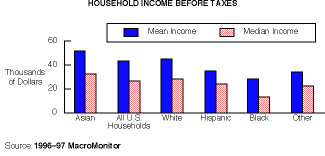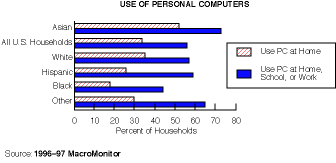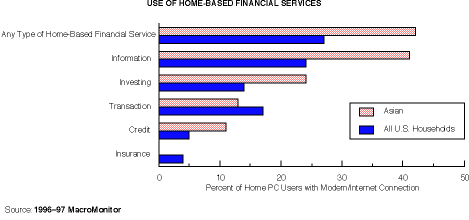Asian-Americans: Through the Middle Class and Beyond MacroMonitor Marketing Report Vol. III, No. 11 August 1998
According to official government projections, minorities will account for almost half of the U.S. population by 2050. In California, no single racial group will be a majority in the twenty-first century. Multicultural marketing and advertising are thus critical to financial institutions that want to compete successfully in the United States now and in the coming decades.
This MacroMonitor Marketing Report focuses on Asian-Americans, a population segment that will likely be one of the most influential consumer groups in the United States in the coming decade. The U.S. Bureau of the Census estimates the Asian and Pacific Islander population at almost 10 million today and about 4% of the total U.S. population. By the middle of the next century, this population group will have expanded to more than 34 million and will account for almost 10% of the total U.S. population.
The size and growth of the Asian-American population, although impressive, account for just a part of the marketing rationale for financial institutions to take heed of this market. More important, Asian-Americans have the highest median income among all ethnic groups, making them prime customers for a wide range of financial products and services. In addition, a very high proportion of Asian-Americans are highly educated, with higher-than-average market penetration of home personal computer (PCs) and Internet users.


The Asian-Americans' high comfort level with and strong preference for conducting non-face-to-face financial transactions (as this report notes) in combination with their strong technology familiarity make this group a strong potential market for technology-based financial services such as online banking and investing. Already, a significantly high proportion of Asian-American home PC users (41%) obtain financial information using home-based financial services to inquire about account balances or obtain information about loans, credit lines, investments, or insurance. About a quarter of Asian-Americans, compared with 14% of all PC users, conduct investment-related activities online. The findings in this study suggest that Asian-Americans may be a critical market niche for financial institutions seeking to capture a larger share of the home-based financial services market.

Asian-Americans represent more than 17 countries, from Korea and China in East Asia to the Southeast Asian countries of Vietnam, Cambodia, and the Philippines, as well as the Indian subcontinent. Despite this population's cultural and linguistic diversity, certain unifying characteristics among Asian-Americans can help financial marketers appropriately target this segment. Most Asian-Americans place a high priority on education and providing for family so that they might live comfortably. In retail finance, this propensity translates into strong interest in financial products that would help meet children's education needs and maximize financial resources (such as through efficient investment and tax planning).
In addition, life and long-term-care insurance as well as retirement products will likely gain importance in the Asian-American households' financial strategy in the coming years. Expecting relatives to take care of one's family in the event of death or old age is likely to become questionable as the younger generation becomes more assimilated into mainstream U.S. culture.
By addressing the needs of the Asian-American market, financial institutions stand to gain significant market growth and profitability. The Census Bureau projects this population segment to have the highest growth rates. Earning high incomes, well-educated, and familiar with technology-based financial services, Asian-Americans can be attractive and potentially profitable financial customers.
This MacroMonitor Marketing Report focuses on Asian-Americans, a population segment that will likely be one of the most influential consumer groups in the United States in the coming decade. The U.S. Bureau of the Census estimates the Asian and Pacific Islander population at almost 10 million today and about 4% of the total U.S. population. By the middle of the next century, this population group will have expanded to more than 34 million and will account for almost 10% of the total U.S. population.
The size and growth of the Asian-American population, although impressive, account for just a part of the marketing rationale for financial institutions to take heed of this market. More important, Asian-Americans have the highest median income among all ethnic groups, making them prime customers for a wide range of financial products and services. In addition, a very high proportion of Asian-Americans are highly educated, with higher-than-average market penetration of home personal computer (PCs) and Internet users.


The Asian-Americans' high comfort level with and strong preference for conducting non-face-to-face financial transactions (as this report notes) in combination with their strong technology familiarity make this group a strong potential market for technology-based financial services such as online banking and investing. Already, a significantly high proportion of Asian-American home PC users (41%) obtain financial information using home-based financial services to inquire about account balances or obtain information about loans, credit lines, investments, or insurance. About a quarter of Asian-Americans, compared with 14% of all PC users, conduct investment-related activities online. The findings in this study suggest that Asian-Americans may be a critical market niche for financial institutions seeking to capture a larger share of the home-based financial services market.

Asian-Americans represent more than 17 countries, from Korea and China in East Asia to the Southeast Asian countries of Vietnam, Cambodia, and the Philippines, as well as the Indian subcontinent. Despite this population's cultural and linguistic diversity, certain unifying characteristics among Asian-Americans can help financial marketers appropriately target this segment. Most Asian-Americans place a high priority on education and providing for family so that they might live comfortably. In retail finance, this propensity translates into strong interest in financial products that would help meet children's education needs and maximize financial resources (such as through efficient investment and tax planning).
In addition, life and long-term-care insurance as well as retirement products will likely gain importance in the Asian-American households' financial strategy in the coming years. Expecting relatives to take care of one's family in the event of death or old age is likely to become questionable as the younger generation becomes more assimilated into mainstream U.S. culture.
By addressing the needs of the Asian-American market, financial institutions stand to gain significant market growth and profitability. The Census Bureau projects this population segment to have the highest growth rates. Earning high incomes, well-educated, and familiar with technology-based financial services, Asian-Americans can be attractive and potentially profitable financial customers.